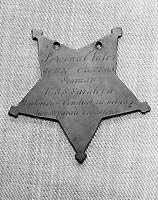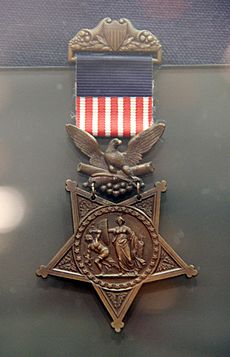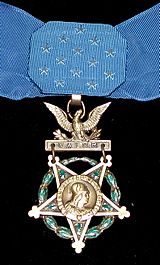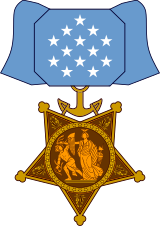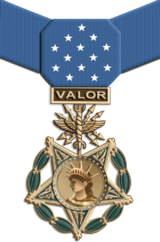Medal of Honor facts for kids
Quick facts for kids Medal of Honor |
|
|---|---|
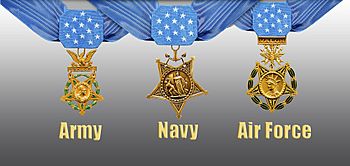
Medals of honor of the three military departments
|
|
| Type | Military medal with neck ribbon (decoration) |
| Eligibility | United States Armed Forces service members |
| Awarded for | Conspicuous gallantry and intrepidity at the risk of life above and beyond the call of duty |
| Status | Currently awarded |
| Statistics | |
| Established | Naval Service: December 21, 1861 Army: July 12, 1862 Air and Space Forces: April 14, 1965 |
| Precedence | |
| Next (lower) | Army: Distinguished Service Cross Naval Service: Navy Cross Air and Space Forces: Air Force Cross Coast Guard: Coast Guard Cross |
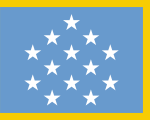 Service ribbon and flag |
|
The Medal of Honor (MOH) is the United States Armed Forces' highest military decoration and is awarded to recognize American soldiers, sailors, marines, airmen, guardians and coast guardsmen who have distinguished themselves by acts of valor. The medal is normally awarded by the president of the United States, but as it is presented "in the name of the United States Congress", it is sometimes referred to as the "Congressional Medal of Honor".
There are three distinct variants of the medal: one for the Army, awarded to soldiers, one for the Naval Service, awarded to sailors, marines, and coast guardsmen, and one for the Air and Space Forces, awarded to airmen and guardians. The Medal of Honor was introduced for the Naval Service in 1861, soon followed by the Army's version in 1862. The Air Force used the Army's version until they received their own distinctive version in 1965. The Medal of Honor is the oldest continuously issued combat decoration of the United States Armed Forces. The president typically presents the Medal of Honor at a formal ceremony intended to represent the gratitude of the American people, with posthumous presentations made to the primary next of kin.
According to the Medal of Honor Historical Society of the United States, there have been 3,530 Medals of Honor awarded to 3,511 individuals since the decoration's creation, with over 40% awarded for actions during the American Civil War. In 1990, Congress designated March 25 annually as "National Medal of Honor Day".
Contents
History
During the first year of the Civil War (1861–1865), a proposal for a battlefield decoration for valor was submitted to Lieutenant General Winfield Scott, the Commanding General of the United States Army, by Lieutenant Colonel Edward D. Townsend, an assistant adjutant at the Department of War and Scott's chief of staff. Scott, however, was strictly against medals being awarded, which was the European tradition. After Scott retired in October 1861, Secretary of the Navy Gideon Welles adopted the idea of a decoration to recognize and honor distinguished naval service.
On December 9, 1861, Iowa Senator James W. Grimes, Chairman on the Committee on Naval Affairs, submitted Bill S. 82 (12 Stat. 329–330) during the Second Session of the 37th Congress, "An Act to further promote the Efficiency of the Navy". The bill included a provision (Chap. 1, Sec. 7) for 200 "medals of honor", "to be bestowed upon such petty officers, seamen, landsmen, and marines as shall most distinguish themselves by their gallantry in action and other seaman-like qualities during the present war, ..." On December 21, the bill was passed and signed into law by President Abraham Lincoln. Secretary Welles directed the Philadelphia Mint to design the new military decoration. On May 15, 1862, the United States Department of the Navy ordered 175 medals ($1.85 each) from the U.S. Mint in Philadelphia with "Personal Valor" inscribed on the back of each one.
On February 15, 1862, Senator Henry Wilson, the chairman of the Senate Committee on Military Affairs and the Militia, introduced a resolution for a Medal of Honor for the Army. The resolution (37th Congress, Second Session; Resolution No. 52, 12 Stat. 623–624) was approved by Congress and signed into law on July 12, 1862 ("A Resolution to provide for the Presentation of 'Medals of Honor' to the Enlisted Men of the Army and Volunteer Forces who have distinguished, or may distinguish, themselves in Battle during the present Rebellion"). This measure provided for awarding a medal of honor "to such non-commissioned officers and privates as shall most distinguish themselves by their gallantry in action and other soldier-like qualities during the present insurrection." During the war, Townsend would have some medals delivered to some recipients with a letter requesting acknowledgment of the "Medal of Honor". The letter, written and signed by Townsend on behalf of the Secretary of War, stated that the resolution was "to provide for the presentation of medals of honor to the enlisted men of the army and volunteer forces who have distinguished or may distinguish themselves in battle during the present rebellion." By mid-November the Department of War contracted with Philadelphia silversmith William Wilson and Son, who had been responsible for the Navy's design, to prepare 2,000 medals for the Army ($2.00 each) to be cast at the mint. The Army's version had "The Congress to" written on the back of the medal. Both versions were made of copper and coated with bronze, which "gave them a reddish tint".
On March 3, 1863, Congress made the Medal of Honor a permanent decoration, and it was authorized for officers of the Army. On March 25, the Secretary of War presented the first Medals of Honor to six U.S. Army volunteers in his office.
In 1896, the ribbon of the Army's version of the Medal of Honor was redesigned with all stripes being vertical. Again, in 1904 the planchet of the Army's version of the Medal of Honor was redesigned by General George Lewis Gillespie. The purpose of the redesign was to help distinguish the Medal of Honor from other medals, particularly the membership insignia issued by the Grand Army of the Republic.
In 1917, based on the report of the Medal of Honor Review Board, established by Congress in 1916, 911 recipients were stricken off the Army's Medal of Honor list because the medal had been awarded inappropriately. Among them were William Frederick "Buffalo Bill" Cody and Mary Edwards Walker. In 1977, the Army's board for correction of military records unilaterally restored Walker's medal at the request of a relative. This was problematic for a number of reasons; the board had no authority to overturn a statute, and the restoration violated not only the period law during the Civil War, but also the law requiring revocation in 1916, and modern law in 1977. As a reaction to Walker's restoration, a relative of Buffalo Bill Cody's requested the same action from the Army's board for correction, and it reinstated the medals for Cody and four other civilian scouts on June 12, 1989.
A separate Coast Guard Medal of Honor was authorized in 1963, but not yet designed or awarded.
A separate design for a version of the medal for the Department of the Air Force was created in 1956, authorized in 1960, and officially adopted on April 14, 1965. Previously, airmen of the U.S. Air Force received the Army's version of the medal.
Appearance
There are three versions of the Medal of Honor, one for each of the military departments of the Department of Defense (DoD): the Department of the Army, Department of the Navy (Naval Service), and Department of the Air Force (Air and Space Forces). Members of the Coast Guard, part of the Department of Homeland Security, are eligible to receive the Naval version. Each medal is constructed differently and the components are made from gilding metals and red brass alloys with some gold plating, enamel, and bronze pieces. The United States Congress considered a bill in 2004 which would require the Medal of Honor to be made with 90% gold, the same composition as the lesser-known Congressional Gold Medal, but the measure was dropped.
Presentation
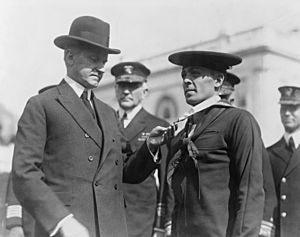
There are two distinct protocols for awarding the Medal of Honor. The first and most common is nomination and approval through the chain of command of the service member. The second method is nomination by a member of the U.S. Congress, generally at the request of a constituent. In both cases, if the proposal is outside the time limits for the recommendation, approval to waive the time limit requires a special Act of Congress. The Medal of Honor is presented by the President on behalf of, and in the name of, the Congress. Since 1980, nearly all Medal of Honor recipients—or in the case of posthumous awards, the next of kin—have been personally decorated by the president. Since 1941, more than half of the Medals of Honor have been awarded posthumously.
Privileges and courtesies
The Medal of Honor confers special privileges on its recipients. By law, recipients have several benefits:
- Each Medal of Honor recipient may have his or her name entered on the Medal of Honor Roll (38 U.S.C. § 1560).
- Each person whose name is placed on the Medal of Honor Roll is certified to the United States Department of Veterans Affairs as being entitled to receive a monthly pension above and beyond any military pensions or other benefits for which they may be eligible. The pension is subject to cost-of-living increases; as of November 22, 2022[update], it is $1,619.34 a month.
- Enlisted recipients of the Medal of Honor are entitled to a supplemental uniform allowance.
- Recipients receive special entitlements to air transportation under the provisions of DOD Regulation 4515.13-R. This benefit allows the recipient to travel as deemed fit, as well as allows the recipient's dependents to travel either overseas–overseas, overseas–continental U.S., or continental U.S.–overseas when accompanied by the recipient.
- Special identification cards and commissary and exchange privileges are provided for Medal of Honor recipients and their eligible dependents.
- Recipients are granted eligibility for interment at Arlington National Cemetery, if not otherwise eligible.
- Fully qualified children of recipients are automatically appointed to any of the United States service academies.
- Recipients receive a ten percent increase in retired pay.
- Those awarded the medal after October 23, 2002, receive a Medal of Honor Flag. The law specified that all 103 living prior recipients as of that date would receive a flag.
- Recipients receive an invitation to all future presidential inaugurations and inaugural balls.
- As with all medals, retired personnel may wear the Medal of Honor on "appropriate" civilian clothing. Regulations specify that recipients of the Medal of Honor are allowed to wear the uniform "at their pleasure" with standard restrictions on political, commercial, or extremist purposes (other former members of the armed forces may do so only at certain ceremonial occasions).
- Forty states offer a special license plate for certain types of vehicles to recipients at little or no cost to the recipient. The states that do not offer Medal of Honor specific license plate offer special license plates for veterans for which recipients may be eligible.
Recipients
- The first Medals of Honor were awarded and presented to six U.S. Army soldiers ("Andrews Raiders") on March 25, 1863, by Secretary of War Edwin Stanton, in his office of the War Department. Private Jacob Parrott, a U.S. Army volunteer from Ohio, became the first actual Medal of Honor recipient, awarded for his volunteering for and participation in a raid on a Confederate train in Big Shanty, Georgia, on April 12, 1862, during the American Civil War. After the medal presentations, the six decorated soldiers met with President Lincoln in the White House.
- The first U.S. Navy sailors were awarded the Medal of Honor on April 3, 1863. 41 sailors received the award, with 17 awards for action during the Battle of Forts Jackson and St. Philip.
- The first marines awarded the Medal of Honor were John F. Mackie and Pinkerton R. Vaughn on July 10, 1863; Mackie for USS Galena on May 15, 1862, and Vaughn for USS Mississippi on March 14, 1863.
- The first, and so far only, Coast Guardsman to be awarded the Medal of Honor was Signalman First Class Douglas Munro. He was posthumously awarded it on May 27, 1943, for evacuating 500 marines under fire on September 27, 1942, during the Battle of Guadalcanal.
- The only woman awarded the Medal of Honor is Mary Edwards Walker, who was a civilian Army surgeon during the American Civil War. She received the award in 1865 after the Judge Advocate General of the Army determined that she could not be given a retroactive commission, and so President Andrew Johnson directed that "the usual medal of honor for meritorious services be given her."
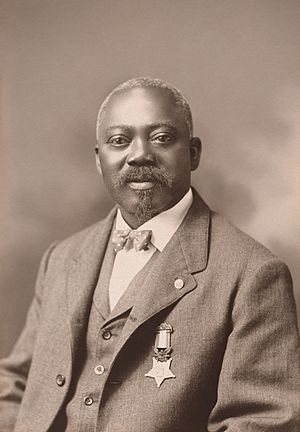
- The first black recipients of the Medal of Honor were sixteen Army soldiers and sixteen Navy sailors that fought during the Civil War. The first award was announced on April 6, 1865, to twelve black soldiers from the five regiments of U.S. Colored Troops who fought at New Market Heights outside of Richmond on September 29, 1864. The first black man to earn the Medal of Honor was William Harvey Carney. He earned the Medal during the Battle of Ft Wagner, but was not presented with it until 1900.
The 1917 Medal of Honor Board deleted 911 awards, but only 910 names from the Army's Medal of Honor list, including awards to Mary Edwards Walker, William F. "Buffalo Bill" Cody and the first of two awards issued February 10, 1887, to George W. Mindil, who retained his award issued October 25, 1893. None of the 910 "deleted" recipients were ordered to return their medals, although on the question of whether the recipients could continue to wear their medals, the Judge Advocate General advised the Medal of Honor Board that the Army was not obligated to police the matter. Walker continued to wear her medal until her death. Although some sources claim that President Jimmy Carter formally restored her medal posthumously in 1977, this action was actually taken unilaterally by the Army's Board for Correction of Military Records. The Army Board for Correction of Military Records also restored the Medals of Honor of Buffalo Bill and four other civilian scouts in 1989.
- Sixty-one Canadians who served in the United States Armed Forces, mostly during the American Civil War. Since 1900, four Canadians have received the medal. The only Canadian-born, naturalized U.S. citizen to receive the medal for heroism during the Vietnam War was Peter C. Lemon.
While the governing statute for the Army's Medal of Honor (10 U.S.C. § 6241), beginning in 1918, explicitly stated that a recipient must be "an officer or enlisted man of the Army", "distinguish himself conspicuously by gallantry and intrepidity at the risk of his life above and beyond the call of duty", and perform an act of valor "in action involving actual conflict with an enemy", exceptions have been made:
- Charles Lindbergh, 1927, civilian pilot, and U.S. Army Air Corps reserve officer. Lindbergh's medal was authorized by a special act of Congress.
- Major General (Retired) Adolphus Greely was awarded the medal in 1935, on his 91st birthday, "for his life of splendid public service". The result of a special act of Congress similar to Lindbergh's, Greely's medal citation did not reference any acts of valor.
- Foreign unknown recipients include five WWI Unknowns: the Belgian Unknown Soldier, the British Unknown Warrior, the French Unknown Soldier, the Italian Unknown Soldier, and the Romanian Unknown Soldier.
- U.S. unknown recipients include one each from four wars: World War I, World War II, Korea, and Vietnam. The Vietnam Unknown was later identified as Air Force First Lieutenant Michael Blassie through the use of DNA identification. Blassie's family asked for his Medal of Honor, but the Department of Defense denied the request in 1998. According to Undersecretary of Defense Rudy de Leon, the medal was awarded symbolically to all Vietnam unknowns, not to Blassie specifically.
| Army | Navy | Marine Corps | Air Force | Coast Guard | Total |
|---|---|---|---|---|---|
| 2,461 | 749 | 300 | 19 | 1 | 3,530 |
Note that the number of Air Force recipients does not count recipients from its pre-September 19, 1947, Army-related predecessor organizations.
Double recipients
Nineteen service members have been awarded the Medal of Honor twice. The first double Medal of Honor recipient was Thomas Custer (brother of George Armstrong Custer) for two separate actions that took place several days apart during the American Civil War.
Five "double recipients" were awarded both the Army's and Navy's Medal of Honor for the same action, with all five of these occurrences taking place during World War I. No modern recipients have more than one medal because of laws passed for the Army in 1918, and for the Navy in 1919, which stipulated that "no more than one medal of honor . . . shall be issued to any one person," although subsequent awards were authorized by issuance of bars or other devices in lieu of the medal itself. The statutory bar was finally repealed in the FY2014 defense bill, at the request of the Office of the Secretary of Defense, meaning that recipients can now be issued more than one medal. However, no more than one medal may be issued for the same action.
To date, the maximum number of Medals of Honor earned by any service member has been two. The last living individual to be awarded two Medals of Honor was John J. Kelly October 3, 1918; the last individual to receive two Medals of Honor for two different actions was Smedley Butler, in 1914 and 1915.
| Name | Service | Rank | War(s) | Notes |
|---|---|---|---|---|
| Frank Baldwin | Army | First Lieutenant, Captain | American Civil War, Indian Wars | |
| Smedley Butler | Marine Corps | Major General | Veracruz, Haiti | |
| John Cooper | Navy | Coxswain | American Civil War | |
| Louis Cukela | Marine Corps | Sergeant | World War I | Awarded both Navy and Army versions for same action. |
| Thomas Custer | Army | Second Lieutenant | American Civil War | Battle of Namozine Church on April 3 and Battle of Sayler's Creek on April 6, 1865. |
| Daniel Daly | Marine Corps | Private, Gunnery Sergeant | Boxer Rebellion, Haiti | |
| Henry Hogan | Army | First Sergeant | Indian Wars | |
| Ernest A. Janson | Marine Corps | Gunnery Sergeant | World War I | Both awarded for same action. Received the Army MOH under the name Charles F. Hoffman. |
| John J. Kelly | Marine Corps | Private | World War I | Both awarded for same action. |
| John King | Navy | Water tender | Peacetime | 1901 and 1909 |
| Matej Kocak | Marine Corps | Sergeant | World War I | Both awarded for same action. |
| John Lafferty | Navy | Fireman, First Class Fireman | American Civil War, peacetime | |
| John C. McCloy | Navy | Coxswain, Chief Boatswain | Boxer Rebellion, Veracruz | |
| Patrick Mullen | Navy | Boatswain's Mate | American Civil War | |
| John H. Pruitt | Marine Corps | Corporal | World War I | Both awarded for same action. |
| Robert Sweeney | Navy | Ordinary Seaman | Peacetime | 1881 and 1883 |
| Albert Weisbogel | Navy | Captain of the Mizzen Top | Peacetime | 1874 and 1876 |
| Louis Williams | Navy | Captain of the Hold | Peacetime | 1883 and 1884. Also known as Ludwig Andreas Olsen. |
| William Wilson | Army | Sergeant | Indian Wars |
Related recipients
Arthur MacArthur, Jr. and Douglas MacArthur are the first father and son to be awarded the Medal of Honor. The only other such pairing is Theodore Roosevelt (awarded in 2001) and Theodore Roosevelt, Jr.
Five pairs of brothers have received the Medal of Honor:
- John and William Black, in the American Civil War. The Blacks are the first brothers to be so honored.
- Charles and Henry Capehart, in the American Civil War, the latter for saving a drowning man while under fire.
- Antoine and Julien Gaujot. The Gaujots also have the unique distinction of receiving their medals for actions in separate conflicts, Antoine in the Philippine–American War and Julien when he crossed the Mexican border to rescue Mexicans and Americans in a Mexican Revolution skirmish.
- Harry and Willard Miller, during the same naval action in the Spanish–American War.
- Allen and James Thompson, in the same American Civil War action.
Another notable pair of related recipients are Admiral Frank Friday Fletcher (rear admiral at the time of award) and his nephew, Admiral Frank Jack Fletcher (lieutenant at the time of award), both awarded for actions during the United States occupation of Veracruz.
Late awards
Since 1979, 86 late Medal of Honor awards have been presented for actions from the Civil War to the Vietnam War. In addition, five recipients whose names were not included on the Army's Medal of Honor Roll in 1917 had their awards restored. A 1993 study commissioned by the U.S. Army investigated "racial disparity" in the awarding of medals. At the time, no Medals of Honor had been awarded to U.S. soldiers of African descent who served in World War II. After an exhaustive review, the study recommended that ten Distinguished Service Cross recipients be awarded the Medal of Honor. On January 13, 1997, President Bill Clinton presented the Medal of Honor to seven of these World War II veterans, six of them posthumously and one to former Second Lieutenant Vernon Baker.
In 1998, a similar study of Asian Americans resulted in President Bill Clinton presenting 22 Medals of Honor in 2000. Twenty of these medals went to U.S. soldiers of Japanese descent of the 442nd Regimental Combat Team (442nd RCT) who served in the European Theater of Operations during World War II. One of these Medal of Honor recipients was Senator Daniel Inouye, a former U.S. Army officer in the 442nd RCT.
In 2005, President George W. Bush presented the Medal of Honor to Tibor Rubin, a Hungarian-born American Jew who was a Holocaust survivor of World War II and enlisted U.S. infantryman and prisoner of war in the Korean War, whom many believed to have been overlooked because of his religion.
On April 11, 2013, President Obama presented the Medal of Honor posthumously to Army chaplain Captain Emil Kapaun for his actions as a prisoner of war during the Korean War. This follows other awards to Army Sergeant Leslie H. Sabo, Jr. for conspicuous gallantry in action on May 10, 1970, near Se San, Cambodia, during the Vietnam War and to Army Private First Class Henry Svehla and Army Private First Class Anthony T. Kahoʻohanohano for their heroic actions during the Korean War.
As a result of a congressionally mandated review to ensure brave acts were not overlooked due to prejudice or discrimination, on March 18, 2014, President Obama upgraded Distinguished Service Crosses to Medals of Honor for 24 Hispanic, Jewish, and black individuals—the "Valor 24"—for their actions in World War II, the Korean War and the Vietnam War. Three were still living at the time of the ceremony.
On November 6, 2014, President Obama presented the Medal of Honor posthumously to First Lieutenant Alonzo Cushing for actions on July 3, 1863, during the Battle of Gettysburg. Lieutenant Cushing's award is the last Medal of Honor to be presented to a soldier in the American Civil War, after 151 years since the date of the action.
On 3 March 2023, President Biden presentethe Medal of Honor to Paris D. Davis (born 13 May 1939), a retired United States Army officer, for his actions on 18 June 1965 during the Vietnam War. He was twice previously nominated for the Medal of Honor, but both times the paperwork relating to his nomination disappeared.
Images for kids
-
Medal of Honor monument and Medal of Honor headstones of the Civil War recipients of "Andrews Raid" at the Chattanooga National Cemetery in Chattanooga, Tennessee.
-
Admiral Eric T. Olson salutes Sergeant First Class Leroy Petry at a ceremony at The Pentagon (July 2011)
See also
 In Spanish: Medalla de Honor para niños
In Spanish: Medalla de Honor para niños
- African-American Medal of Honor Recipients Memorial
- Distinguished Intelligence Cross
- Home of the Heroes, a recognition of Pueblo, Colorado, for being the hometown of four Medal of Honor recipients
- Kentucky Medal of Honor Memorial
- List of Medal of Honor recipients
- Medal of Honor Memorial (Indianapolis)
- Merchant Marine Distinguished Service Medal
- Military awards and decorations
- Texas Medal of Honor Memorial


